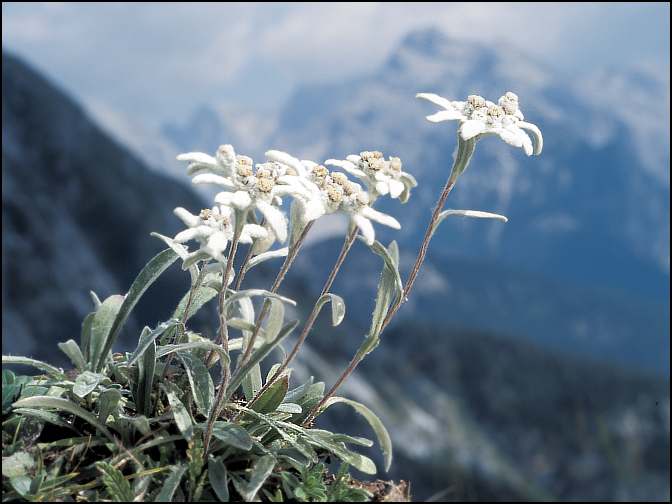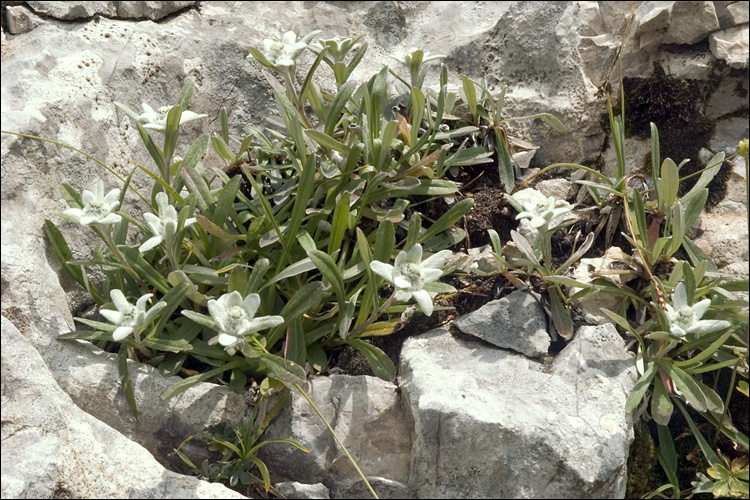Form and Function
How is Edelweiss able to thrive in its environment due to its form and function?
As mentioned in the Home
page, Leontopodium alpinum lives in an alpine environment,
suggesting it enjoys cool, rocky, and sunny environments. Therefore,
just like any other organism, it must develop certain structural
components to be able to live and multiply in its environment.
Edelweiss has done this in several ways, and the examples that
follow should help you to understand how each individual constituent
works with the others to create a stable, optimal, and thriving
lifestyle for the Edelweiss plant. It is important to recognize
that, overall, Leontopodium alpinum has
many typical plant parts, including a stem, leaves, primary xylem, and
primary phloem to name a few. Edelweiss has the unifying traits of all
Angiosperms, but the structure and function discussed below are
mostly unique to this organism.

One of the most unique structural elements that Edelweiss has
developed over time is “white filamentary hair that cover the
bracts” (thick leaves) of the plant (Vigneron et al 2005). Upon
examining this structure with an electron microscope, it is believed
that the Edelweiss plant is one example of a minimal number of
plants to exhibit an "internal photonic structure" (Vigneron et al
2005). This observation
is incredibly astounding to biologists because it implies that the
plant can absorb ultraviolet light. Many plants are unable to absorb
ultraviolet light, includuing
Brassica rapa (turnip),
Cucumis sativus (cucumber), and
Glysine max (soybean). The main question explored in
the article is whether the bracts or the filamentary hairs are
responsible for the absorption of this ultraviolet light, seeing as
without this absorption, such strong rays of light could be very
damaging to the cells of the plant, causing mutations, similar to
radiation in humans. (Vigneron et al 2005). The tremendously
interesting result from research is that the “wooly” part of the
flower protects the plant from ultraviolet light without hampering
its ability to absorb visible light, which is truly remarkable.
Returning to the discussion of filamentary hairs and their photonic
structure, it is important to recognize how ridiculously small these
hairs are—fractions of a micrometer, if that is even fathomable. The
hairs themselves are “tubular internally, with parallel striations”
(Glover and Whitney 2009). As rare as this structure is in plants,
it is not completely absent from other organisms, and can be found in the
Monarch butterfly,
Predaceous diving beetle, and the feathers (that change colors)
in birds (Vigneron 2005). These hairs are fully responsible
for the absorption of damaging light rays, and are found on the bract
of the plant—the thick-leafed part that is often
mistaken for the petal of the flower.
This hair also protects against dehydration, particularly because of
the cold and windy alpine environment (see
Habitat), and keeps the internal cells
at an optimal temperature for functioning properly.
While Edelweiss is indeed a flowering plant (Angiosperm), the flower
itself is not what one would initially perceive upon looking at the
plant. The “wooly ‘petals’” are not actually part of the flower, but
instead are a type of leaf called a bract, as mentioned earlier. The
flower component of the plant is, in retrospect, “incredibly small
and inconspicuous,” and are essentially the yellow freckles
noticeable in the center of the wooly leaves (Johnston 2012). These
flowers sometimes remain hidden under the hairs and the blooming
period can span up to a week, beginning first in the outer ring and
then near the flower’s head (see
Reproduction). While the hair-covered parts of the
plant are perhaps the most striking and obvious, many of the leaves
are not actually covered in this protective hair, most likely
because they are located under the larger mass of the plant and are
thus already protected from the strong ultraviolet light (Johnston 2012).

Similar to many other members of the Asteraceae family, the
“flower’s anthers are hidden in a mast where the stigma rests and
eventually contacts these pollen-covered anthers, after which the
pollen sticks to the stigma and is able to be carried with it”
(Johnston 2012). Flower disks are considered to be the circular
clusters of yellow flowers that are visible in the Edelweiss plant.
These disks can grow almost anywhere, including on parts of the
stem, and live out their lifespan as a group, turning a brown color
after their blooming cycle is complete. Leontopodium alpinum
is widely protected because if the flower heads are picked from
the plant on more than one occasion, it loses the ability to
propagate by seeding; it is therefore known as a “short-lived perennial”
(Johnston 2012).
Just like many other plants, compounds found in Edelweiss have been
used for medicinal purposes for many years. One such example is
leoligin, a metabolite from the roots of the plant that is able to
"inhibit intimal hyperplasia in human saphenous veins"—thickening of
the vein in response to trauma or healing (Reisinger et al 2008).
While this is just one example, few people are aware that many of
the small parts of a plant, like metabolites, can be so important
structurally and functionally.
The overall structure of Leontopodium alpinum is not
unique, but the bits and pieces that connect the entire plant prove
to be very much one-of-a-kind. While many typical plant parts exist,
there are several components of Edelweiss that cannot be found
in any other organism. All of these components work together to help
Leontopodium alpinum thrive in the dry,
cold, and rough environment it lives in, and it is important to
understand that no one factor ensures the health and prosperity of
this brilliant plant.
I hope this page has helped you highlight the unique aspects of
Edelweiss and how these components connect to the plant’s lifestyle.
Back to Home Forward to Reproduction
Please see the References page for information about where this data was aqcuired.
This page was written by Lizzy Wlodyga